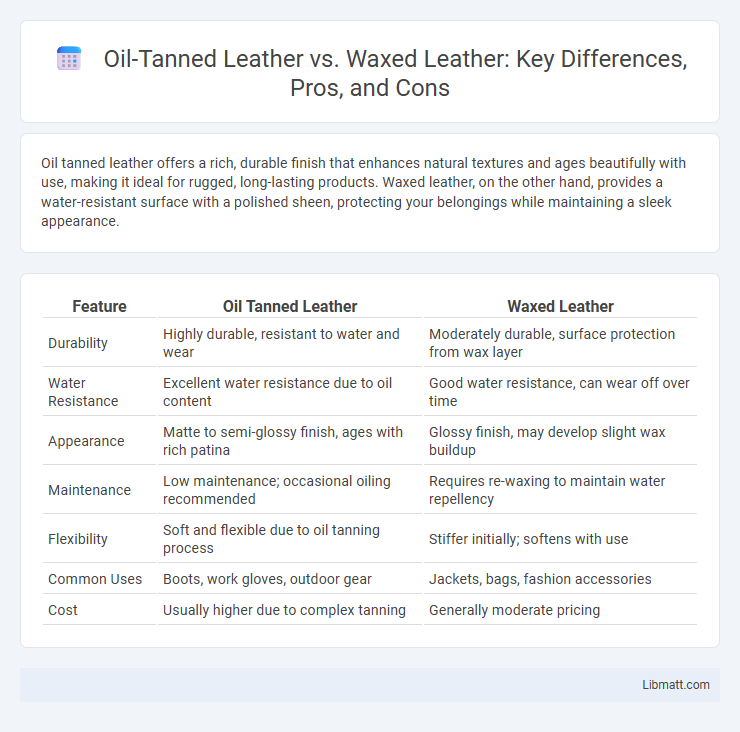Oil tanned leather offers a rich, durable finish that enhances natural textures and ages beautifully with use, making it ideal for rugged, long-lasting products. Waxed leather, on the other hand, provides a water-resistant surface with a polished sheen, protecting your belongings while maintaining a sleek appearance.
Table of Comparison
| Feature | Oil Tanned Leather | Waxed Leather |
|---|---|---|
| Durability | Highly durable, resistant to water and wear | Moderately durable, surface protection from wax layer |
| Water Resistance | Excellent water resistance due to oil content | Good water resistance, can wear off over time |
| Appearance | Matte to semi-glossy finish, ages with rich patina | Glossy finish, may develop slight wax buildup |
| Maintenance | Low maintenance; occasional oiling recommended | Requires re-waxing to maintain water repellency |
| Flexibility | Soft and flexible due to oil tanning process | Stiffer initially; softens with use |
| Common Uses | Boots, work gloves, outdoor gear | Jackets, bags, fashion accessories |
| Cost | Usually higher due to complex tanning | Generally moderate pricing |
Introduction to Oil Tanned and Waxed Leather
Oil tanned leather undergoes a tanning process using natural oils, producing a durable, water-resistant material with a rich, supple texture ideal for rugged goods and outdoor gear. Waxed leather is treated with wax-based finishes, creating a sleek, glossy surface that enhances water repellent qualities while maintaining flexibility and a vintage aesthetic. Both types offer unique protective properties, with oil tanned leather excelling in longevity and waxed leather favored for its distinctive sheen and moisture resistance.
What is Oil Tanned Leather?
Oil tanned leather is a type of leather treated with natural oils and waxes during the tanning process, enhancing its durability, suppleness, and water resistance. This method preserves the leather's natural texture and provides a rich, rugged patina that improves with age. Your choice of oil tanned leather ensures a long-lasting, flexible material ideal for footwear, bags, and outdoor gear.
What is Waxed Leather?
Waxed leather is a type of leather treated with a layer of wax or oil to enhance its water resistance and durability. This process creates a distinctive matte or slightly glossy finish that develops a rich patina over time, offering increased protection from moisture and wear. Your choice between oil tanned and waxed leather depends on the desired look and level of maintenance, with waxed leather requiring less frequent conditioning.
Manufacturing Processes Compared
Oil tanned leather is produced by soaking hides in a mixture of oils and waxes, which penetrates deeply to enhance softness and water resistance through a natural tanning method. Waxed leather undergoes a treatment where melted wax is applied on the surface of already tanned leather, creating a protective, glossy finish that repels moisture and improves durability. Understanding these manufacturing differences helps you choose the best leather type for your desired balance of texture, protection, and maintenance.
Appearance and Texture Differences
Oil tanned leather features a rich, deep color with a slightly glossy finish and a supple yet firm texture that softens over time, revealing natural creases and a rugged patina. Waxed leather typically has a matte or semi-gloss finish with a smoother, slightly stiffer texture due to the wax coating, which enhances water resistance and durability. Over time, waxed leather can develop a distressed look with unique marks and variations, while oil tanned leather emphasizes warmth and organic aging characteristics.
Durability and Resistance to Elements
Oil tanned leather offers exceptional durability and strong resistance to water, making it ideal for harsh weather conditions and outdoor use. Waxed leather provides a protective wax coating that repels water and dirt while maintaining flexibility, but it may require more frequent reapplication to sustain its resistance. Choosing the right leather depends on your need for long-lasting toughness versus easy maintenance against environmental elements.
Maintenance and Care Requirements
Oil tanned leather requires regular conditioning with natural oils to maintain its supple texture and water resistance, preventing it from drying out and cracking over time. Waxed leather demands less frequent conditioning but benefits from occasional reapplication of specialized wax to preserve its water-repellent finish and enhance durability. Both leather types should be kept away from excessive heat and direct sunlight to avoid damage and maintain their appearance.
Common Uses and Applications
Oil tanned leather is commonly used in rugged outdoor gear such as boots, belts, and work gloves due to its durability, water resistance, and natural aging properties. Waxed leather is often found in fashion accessories, handbags, and jackets, prized for its smooth finish and ability to repel water while maintaining a polished appearance. Both types are favored in products requiring a balance of aesthetics and functionality but cater to different performance needs in varying environments.
Pros and Cons: Oil Tanned vs Waxed Leather
Oil tanned leather offers superior water resistance and durability due to its deep oil infusion, making it ideal for rugged use but can darken significantly over time. Waxed leather provides a more natural look with a smooth finish and is easier to clean, yet it is less breathable and may crack if not properly maintained. Your choice depends on whether you prioritize long-lasting toughness with rich aging (oil tanned) or a sleek appearance with moderate protection (waxed).
Which Leather Type Should You Choose?
Oil tanned leather offers superior durability and water resistance, making it ideal for rugged use and outdoor gear, while waxed leather provides a softer texture with a vintage, matte finish that develops a rich patina over time. Choose oil tanned leather if you need long-lasting protection against the elements and prefer a sturdier feel, whereas waxed leather suits those seeking style, flexibility, and a lighter waterproof barrier. Consider usage conditions, maintenance preferences, and desired aging characteristics when deciding between oil tanned and waxed leather.
Oil tanned leather vs waxed leather Infographic

 libmatt.com
libmatt.com